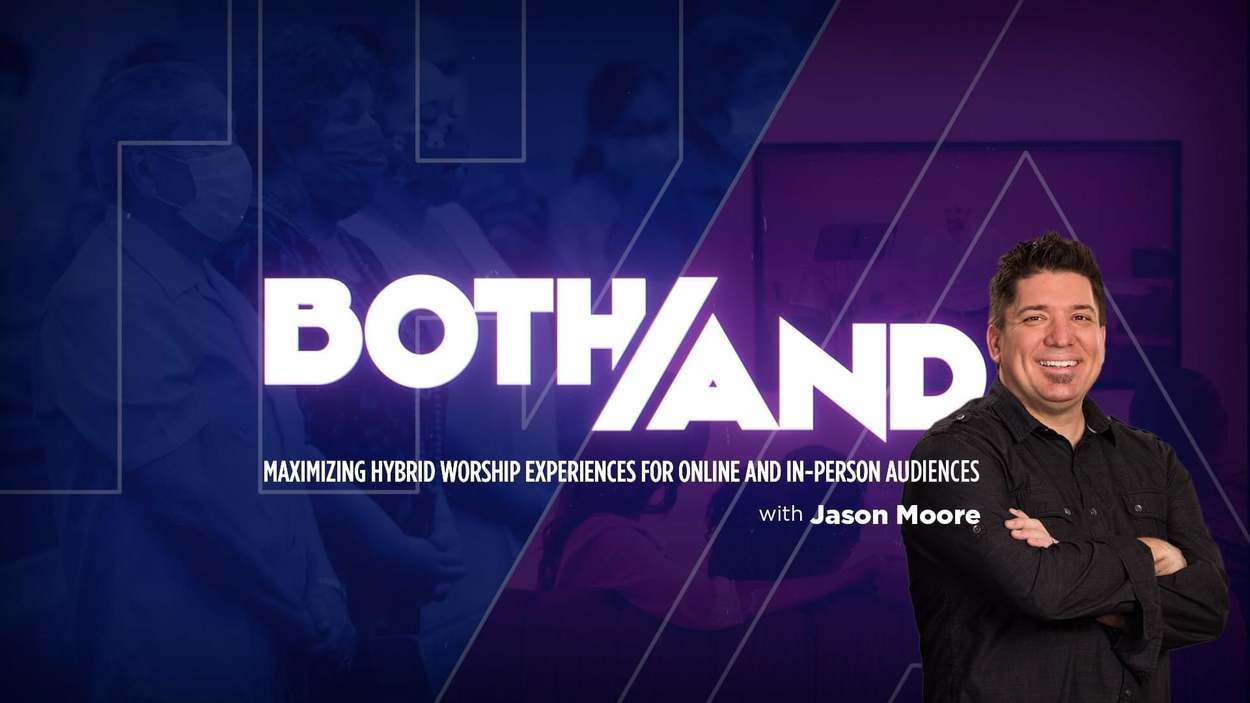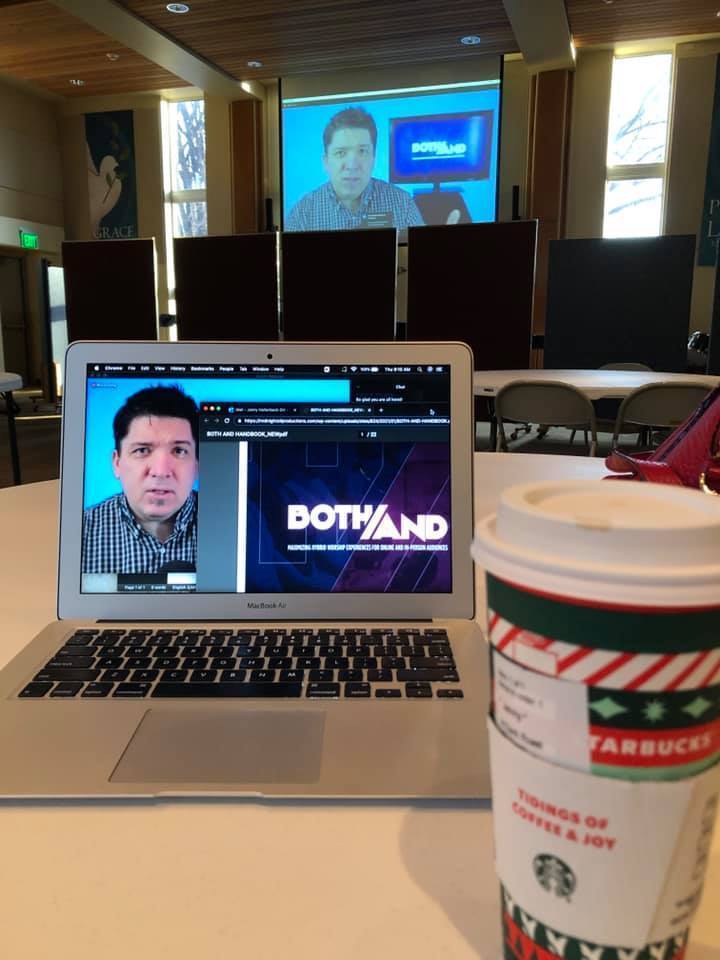
3 strategies to hybrid worship from Jason Moore webinar

Photo illustration by Jason Moore.
“Online worship has allowed us to reach people that would have never walked into our church doors,” says Jason Moore, founder and owner of Midnight Oil Productions. “I have a passion for creating deep and meaningful worship experiences. The question the pandemic leaves us with is, how do we worship both in-person and online without leaving anyone out?”
Moore recently presented a two-hour webinar with more than 100 participants titled, “Both / And: Maximizing Hybrid Worship Experiences for Online and In-Person Audiences.”
Moore said to the participants in the webinar across the Dakotas and Minnesota Conferences, “We will lose the momentum we have gained if we are not careful as we move into this next season of ministry. One of the hardest things that we have learned during the pandemic is that we need to make connections even though we may not see people in our church buildings.”
Many online worship experiences started before the COVID-19 pandemic by merely putting a camera at the back of a sanctuary and broadcasting through an online platform. Those people viewing online were not considered the primary audience. When COVID-19 hit, the only way for people to engage in worship was online.
“Everyone was getting online; we began talking to people through the camera, and that was our primary audience,” says Moore.
As congregations go back to worshiping in-person, worship leaders are challenged to reach people in-person and online. Moore states that we could mistakenly turn the in-person worship experience into a studio audience and give our attention to the camera, making the people in the room feel like an afterthought. Or, with people worshipping in-person, back in our sanctuaries, we might begin to talk to them and forget about the people online. Online worshippers would then feel like observers.
He suggests that we re-imagine worship and think like filmmakers. The first filmmakers placed a camera in the back of the theater, recording what was happening on stage from a distant perspective. There were no camera close-ups or moving cameras. It was a new experience for the viewing audience when filmmakers moved the cameras on stage, and added close-ups and moving cameras.
Moore says, “Worship leaders today need to think like the filmmakers. How do you bring in-person worship to film? We have to create both in-person and online worship experiences, forever, moving forward. Why? There are people who you are reaching that will never walk into your church. People who are experiencing the transformational power of Christ through the worship we are doing online.”

Rev. Jenny Hallenbeck Orr's photo on Facebook as she views the "Both/And" webinar.
Reimagine worship
To make that happen, Moore suggests that we have to reimagine worship in four ways:
1. Consolidate the experience: Worship online has to be consolidated. In-person worship can be longer than online. The average in-person worship experience is a little more than one hour. That feels OK for most people.
Facebook analytics reveals that viewers will watch online for 25-30 minutes, maybe a 40-minutes maximum. Nona Jones, who leads faith-based partnerships for Facebook, says, “Keep it tight. Keep it interesting. Keep it engaging. Do not go longer than 25-35 minutes.”
2. Adapt what you do. “You are not changing the message of the Gospel. You are making new wineskins,” Moore says.
Music is one area needing adaptation. Most people viewing online do not sing all the songs and the verses. Showing only the lyrics on the screen creates a gap in the human connection for the online viewer. Seeing the singer and the lyrics is helpful for those viewing online.
Other worship elements that need adaptation are communion and online giving. Audiences will need guidance about why and how to participate in the offering. “Money follows mission, not church budgets,” says Rev. Michael Slaughter, Passionate Churches, LLC.
Move announcements to the end of your worship for online worshippers. Use the announcements as a way to extend their commitment or an extension of the worship service. Announcements should be about how you can live out what happened in worship.
3. Iterate and innovate to make the worship experience fresh, inviting, and inspiring. Keep trying new things. “When you lose the spirit of innovation, people tend to tune out,” says Moore. Predictability causes boredom and complacency. Tweak one thing or try one small thing new in each sermon series or season.”
Things need to look and feel different, perhaps more casual, engaging, and not the same as week after week. “Too many church leaders will step right back into the past the moment they step back into their buildings,” says Carey Nieuwhof. “Where we were no longer exists. We have to move forward, not backwards.”
4. Properly prepare, so you do not lose people during worship. Talk through what you are going to do before your start. Walk through the service, and plan the transitions and flow. Moore says, “How you get from one worship element to the next is important. Pray for the Holy Spirit’s presence.”
Reimagining and shaping worship into a meaningful experience is the new mindset we need to embrace, states Moore. The experience is not like a pageant where several people get up and do their part. In a pageant, there are no connections between the components. Cohesion and connection are essential. People viewing online will click off or leave to find another, more meaningful service online if the experience is disjointed.
Four key questions worship leaders need to ask to create a cohesive worship experience are:
- What is the driving scripture, and what big idea does it present? All worship elements, music, prayer, liturgy, and even the announcements should connect to the big idea.
- What felt need are people walking in with that relates to this scripture? Think about your context and what are the needs and challenges people are facing.
- What is your “hook?” What does it look like? Make the worship experience visual. What is something that people can hang onto or remember?
- What is the goal of this experience? People need to feel inspired and take something away. As people leave the experience, what is the thing you want people to do?
Three strategies
Moore presented three strategies or approaches to providing worship experiences in-person and online: Pre-Both / And Worship, Real-time Both / And Worship, and Post-Both / And Worship. Here is a little more about each of them.

Photo by Samantha Borges on Unsplash.
1. Pre-Both / And Worship: These are different experiences for online and in-person worshippers. Online is pre-recorded, exclusively for those people who worship online. Separate in-person worship happens for those who come to the building. This strategy does not involve live streaming. The worship service is designed for the audience, and the worship leaders are engaged with the specific audience that is being addressed.
This strategy requires human resources to record, edit software, and equipment for recording. Pre-planning of the service is necessary. Consider a shorter service 25-30 minutes, no more than 40 minutes, for the pre-recorded online worship service. Shorten the amount and length of music and the length of the sermon. The call to action should be included and presented differently to those viewing online.
Give some thought to whether the online and in-person services will be available, synchronously available—at the same time or asynchronously available—at different times. If you broadcast synchronously, often livestream numbers are lower at the time of release or broadcast. The number of viewers who watch after the broadcast time is higher.
Because you do not know when viewers will watch, it is essential to make your content evergreen. Ask, what will the experience be like if people watch the worship service one month from today? Try to avoid time placements or restricting the content to a specific timeline—yesterday, today, tomorrow. Avoid conditional content—comments or content based on the previous content, “last week, I talked about this.”
Provide hospitality for online viewers through an online worship host. The host connects and relates to those who are commenting, welcoming viewers to the experience, and walks the viewer through the service for things like giving and the call-to-action.
An online worship host should be articulate, comfortable on camera, understand the technology, available, and willing to engage—in chat and other ways with worshippers, and in-the-know about what is happening in the church community. The host helps the worshipper move from a monologue to a dialogue experience.
2. Real-time Both /And Worship: The real-time strategy to worship allows worshippers to watch a service live online and to attend the in-person worship service. Worship is designed in such a way that attention is given to both audiences simultaneously. At the moment, this happens live and may include a combination of live and pre-recorded elements for the online viewer.
This approach is similar to professional sports events, some people or fans are at the stadium or the game, and others are watching on TV or the broadcast. The broadcast involves graphics, multiple cameras, great audio, and smooth transitions. Engagement is different for the in-person experience and the broadcast or online experience. The real-time strategy allows all worshippers to have the experience at the same time. The potential exists to engage online and in-person worshippers with each other.
There is a need to pay attention to two different audiences. Timing for online should be shorter than in-person. One option for making the online service shorter could be a staggered approach. For example, in-person starts at 10 a.m. with several music selections or songs, and online starts at 10:10 a.m., during the last song of the opening. At the end of the service, or after the sermon, cut away to announcements or closing that are either pre-recorded or led by the online host.
Not everything that happens during in-person worship translates well to online worship. Alternate moments need to be created for the online worshippers. Pay attention to these worship elements: communion, offering, special moments, or recognitions.
There are four different audiences: the in-person audience, the online audience already connected to the faith community, the visitor or guest audience connecting online or in-person for the first time, and the delayed viewer audience—who watches worship at a different time. It is important to create participation and engagement opportunities for each of the audiences. Tools that help with participation include texting apps such as Text in Church and online survey experiences such as Mentimeter. A connection can happen by naming people in the different audiences that connect to the content like, “my friend Matt, who is viewing online now, has tried this. Sally, who is worshipping here in our sanctuary, has tried this. If you are viewing this now and have tried this, text us at…”
3. Post Both / And Worship
Worship is offered in real-time for the in-person audience. The worship is captured, edited, and repurposed for the online audience. The worship experience is made available online for a later time for viewing.
One consideration with this strategy is developing engagement and participation processes for the online viewing audience. Build a chat strategy and a digital hospitality team. Announce times that the digital hospitality team and chat feature will be active for the viewing audience. The chat host can create engagement by posting statements, asking questions that reinforce the sermon, and inviting participants to the call-to-action. To assist the digital hospitality team, prepare a document ahead of time with links, questions, and key points. Encourage viewers to use hashtags and create watch parties.
As churches move forward with creating hybrid online and in-person worship experiences, quality is key. Moore has created this list of questions to audit your worship experience:
- What is the purpose of this aspect of worship, and does it translate to all of the audiences?
- Does this moment belong in both worship experiences?
- Is there a participatory or interactive way of doing this?
- Is this element too short or too long for the audience?
- How does this translate on-screen at home, and do we need an alternate moment?
- Does this need additional contextualization for either audience?
- How will a first-time viewer or in-person guest receive this?
“There is a pretty dramatic shift happening. Begin to think about how you will make the shift and invite more people to Christ,” says Moore.
Resources:
.jpeg)
View a recording of the January 14, 2021 webinar here, available only until February 14.
View the handbook from the January 14, 2021 webinar here, available only until February 14.
Dakotas-Minnesota Digital Campus Initiative grants for training and coaching to reach new people digitally. Applications are due January 24, 2021. Access details here.
Engage conference, free of charge, February 1-2, 2021, a technology conference for church leaders and communicators. Access details here.
She Leads the Church, March 3-4, 2021, a summit for women in church leadership. Access details here.